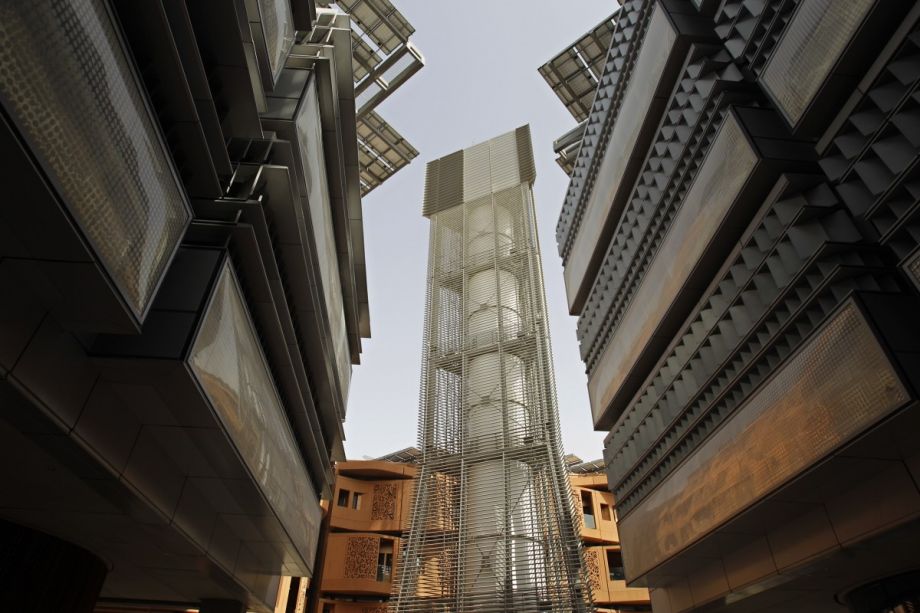Over the last 10 months, as President and Publisher of Next City, I’ve had the opportunity to see the future. From the New York Times’ Cities of Tomorrow conference and the Chicago Forum on Global Cities through SXSW Eco in Austin and the Meeting of the Minds in Berkeley, I encountered people, places and ideas that are changing the way we think about cities, mobility, culture and the environment. Our Vanguards rocked Reno, with a Big Idea Challenge that is transforming 4th Street as well as the way local leaders think about their city. And, COP21 in Paris changed the debate on how we think and act on climate change. I’m intrigued to see in Next City posts that these innovations are being replicated in cities around the country and around the world.
But none of this could have prepared me for what I experienced recently in Dubai and Abu Dhabi, where the pursuit of innovation is paramount, and disruption is embraced. In a world where change is becoming the norm and the potential for conflict is a daily occurrence, these Arab leaders exhibited a sense of purpose and indeed fearlessness that used to be the standard of excellence in America, and provided insights that urbanists should find valuable.
Recently, the United Arab Emirates hosted the World Government Summit — an international community of over 4,000 government authorities, academic intuitions, private sector officials and international organizations from over 90 countries to explore the future of governments. A federated nation of seven emirates that look a lot like city-states, with Dubai and Abu Dhabi driving the economy and culture of the country, the UAE is not well known by most Americans, and is often perceived as a culture of subjugation and inequality. Indeed, only 21 percent of the population are Emiratis with full rights to vote. However, as Bob Dylan sang, “The times they are a changin’.”
WGS presented a new face for UAE and a challenge to the rest of the Arab world. I left with a sense that they are thinking more broadly and competing on the international stage. In and of itself, this is worth further exploration, for cities are no longer in competition with their neighbors, but with distant lands and ideas that can and are being nurtured in places that are only now coming of age.
Here are my six takeaways from the World Government Summit in Dubai and a tour of Masdar City in Abu Dhabi.
1. Women, Youth and Happiness Rule — In one bold stroke, the ruler of Dubai sought to forever change the outward face of the United Arab Emirates. Via Facebook, Prime Minister Mohammed Bin Rashid Al Maktoum announced the largest structural change in the UAE’s history, appointing five women, including a 22-year-old, to meet the demands of an evolving economic and social landscape. New ministers for Tolerance, the Future, Youth, Climate Change and Happiness have the potential for transforming Dubai, Abu Dhabi and other cities along the Persian Gulf in a manner not seen before. Urban researchers Ed Glaeser and Ricky Burdett have been looking at the happiness of residents of big cities and finding far higher levels of life satisfaction in urban areas. Will it work, or is the idea of a Minister of Happiness one more step toward “1984”? The world will be watching as economic and social inclusion are the driving forces of the 21st century.
2. Museum of the Future — How could this be, you say? Museums are supposed to be about documenting the past, right? In another groundbreaking moment that could lead to technological innovations, the museum challenged WGS participants to consider biomechanical miniaturized consumer enhancements for your brain, body and lifestyle, designed to maximize human performance. Would you accept an implanted chip that translates social media and economic performance data into actual smells? How about swallowing a micropill that expands your stomach for up to two weeks of worry-free eating? Or, a retinal overlay that enables you to see the world through someone else’s eyes, broadcasting your visual and sensory feed to friends and colleagues? Artificial intelligence as an economic driver could be the next industrial revolution, and one that cities are well-primed for given the creative talent and tolerance exhibited in most successful cities.
3. Edge of Government Shows It Can Be Done — Exhibits organized by the Mohammed Bin Rashid Center for Government Innovation in partnership with the Abraaj Group addressed some of the most important challenges of our time, including health, environmental protection, public safety and citizen engagement. Organized around a set of emerging themes in public innovation and reflecting a new pattern of public sector problem-solving, the exhibits focused attention to process transformation, collective intelligence, technology reinvention, active infrastructure, behavior-inspired government and data-led effectiveness. While I wasn’t keen on the idea of using Detector Rats to prevent the spread of disease and detect land mines, I was intrigued by Droneports — where the Government of Rwanda is working with the Swiss-based charitable foundation Redline and architect Lord Norman Foster to establish the world’s first network of multipurpose hubs to enable small unmanned aircraft to deliver critical medical supplies to heretofore unreachable places. Most fascinating was the Air Purifying Facade, which Mexico City is advancing as a structural solution that cleans the air and looks cool! In cities such as Beijing, New Delhi, Santiago and Bakersfield, California, where you can often see the air, having building facades absorb particulates is a stopgap measure that can possibly mean life or death to those with asthma or other chronic breathing conditions.
4. Take That, ISIS — The Forgotten Legacy of Arabic Science and the Technology of Tomorrow — In a very powerful one-two punch, Arab leaders were challenged to advance a better future by recalling their past. Klaus Schwab, founder and executive chairman of the World Economic Forum spoke of the dawn of the fourth industrial revolution, “which changes not only what we are doing; it changes us.” Leadership requires brains, soul, heart and nerves, where “the unthinkable in many ways must be thinkable.” These are important lessons for mayors and others willing to inspire change. Jim Al-Khalili, professor at the University of Surrey, cited groundbreaking example after example of how Arabs a thousand years ago ruled the scientific community. The Golden Age of Science was a period of tolerance and exclusivity. And, Neil deGrasse Tyson, director of the Hayden Planetarium, recalled “Futureland” images from his trip to the 1964 World’s Fair to say about Dubai, “This is the city of tomorrow that I was looking for, that never got built.” Noting that the science of today is the mother of technology tomorrow, Tyson called for a “culture of discovery.” Which leads me to the question, would a President Trump really deny a working visa to the brightest Muslim minds? More locally, do you and your mayor understand how creative talents drive urban growth, and do our local and national policies enable the best and brightest minds to thrive in our cities?
5. Technology, Disruption and Futurists, Oh My! — While there was not unanimous agreement on whether technology would address or exacerbate conflicts, change-makers from Jennifer Pahlka and Tim O’Reilly of Code for America to Brogan BamBrogan of Hyperloop Technologies reminded government leaders that regulatory reform and a new service model are essential to creating the future we want. MIT Professor Nicholas Negroponte decried the growing trend toward nationalism — “Exceptionalism is a disease” — and exhorted, “Do things that are self-evident and big.” And former Mexican President Felipe Calderón, who now heads a global commission on the New Climate Economy, encouraged Arab leaders to continue to address climate change as an economic as well as environmental and social driver. Innovation in the 21st century requires a new regulatory model; the most successful cities recognize this and are enhancing planning capacity, streamlining permitting and investing in infrastructure to produce efficient, effective, equitable and attractive communities.
6. Is the City of Tomorrow Being Built Today? — Adjacent to the Abu Dhabi airport is Masdar City, a $22 billion sustainable development project my New Jersey Institute of Technology students have been talking about for a number of years. With personal rapid transit (PRT), a massive solar energy installation, climate-attuned architecture and great minds at IRENA and the Masdar Institute exploring sustainable energy and nanotechnology, Masdar is a real-time laboratory for cities of the future. Some are asking, “Is the world’s first zero-carbon city a big failure?” Although the pace of development was greatly slowed by the global recession and the falling price of oil, with only 5 percent of the footprint finished, there’s construction throughout the site, with new housing, transportation and retail expected to open within the next year. Siemens and IRENA located their corporate offices there. Maybe not the next Silicon Valley, but expect this aerotropolis concept to gain flight in other cities around the world, and provide examples of how to fix cities using sustainable planning.
WGS ended with UAE’s commitment to track progress using the UN-approved Sustainable Development Goals and the COP21 Paris Climate Agreement. If, as former Mayor Michael Bloomberg says, “What gets measured gets done,” Dubai in 2017 could be the mecca for enlightened leadership and thinking for cities around the world trying to tackle climate change, sustainability and a higher quality of life. Yes, social cohesion is key to all of this, and the world will be watching to see if this will shape the future of cities.

Tom was president, CEO and publisher of Next City from May 2015 until April 2018. Before joining Next City, he directed the Center for Resilient Design at the College of Architecture and Design at the New Jersey Institute of Technology. Prior to that, he ran the Regional Plan Association’s New Jersey office, and served as a senior adviser on land use for two New Jersey governors. Tom is a licensed professional planner, and a member of the American Institute of Certified Planners, as well as an adjunct professor at the New Jersey Institute of Technology, where he teaches land use planning and infrastructure planning.










